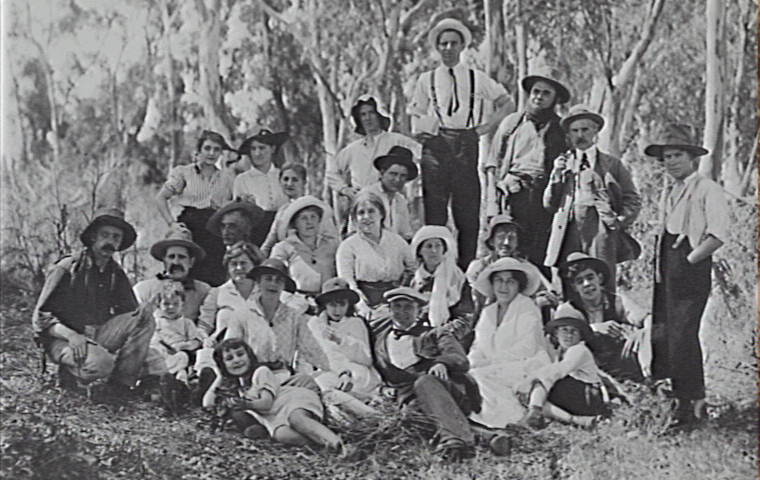In keeping with episode 31’s semi-theme of our local film (and television) industry, we take the opportunity to look back at some of Adelaide’s celluloid glory from a century ago.
Algie’s Romance
Algie’s Romance was a silent film from 1918, put out by the South Australian Feature Film Company. It was directed and produced by Leonard Doogood and co-written by him and Keith Yelland. Doogood was a Charlie Chaplin impersonator, and stars in the film with Boyd Irwin, and May and June Henry. No known footage of the film survives today. The film was shot on a cattle station belonging to the notable Downer family, near the Mount Lofty Ranges.
The plot follows simple lines – Algie is an Englishman, and arrives in Australia to stay with friends in the country. Twin sisters both fall in love with him. Throughout the film, practical jokes are played on poor old Algie, but he eventually gains the upper hand – proving himself a crack shot and gaining a wife.
Our Friends, The Hayseeds

One of eventually seven films in a franchise, Our Friends, The Hayseeds was written, directed and produced by theatrical entrepreneur Beaumont Smith in 1917. Credited with cinematography is Harry Krischock. Another silent film, this one is also considered to be lost.
The cast includes Roy Redgrave, Walter Cornock, Pearl Hellmrich, Margaret Gordon and Percy Mackay.
The plot deals with the Hayseeds and their rural neighbours, the Duggans. Joe Hayseed and Pansy Duggan’s desire to be married is hindered by a quarrel between the two families. However, the families become united in fighting a bushfire, and the two youngsters eventually marry. Pansy becomes pregnant, and the patriarchs of the Hayseed and Duggan families wish for a boy (in the hopes that he will be named after them). Disappointment ensues when Pansy ends up giving birth to twin girls.
Shooting for the film was on location in the Campbelltown and Norwood areas. The bushfire scene was filmed on a hill at Campbelltown, with the fire getting out of control and trapping the actors for a period of time.
The Woman Suffers
Written and directed by Raymond Longford and starring Lottie Lyell, the melodramatic The Woman Suffers was a somewhat controversial film following its release in 1918. After running for seven weeks, it was banned in New South Wales with no reason given. The film was another Southern Cross Feature Film Company production, with cinematography by Arthur Higgins.
In the film, Marion Masters flees her drunken husband, taking their baby son with her. Falling on a knife, Mr Masters dies. Subsequently the family home is destroyed in a fire, and Marion collapses in the bush. (I’m not making this up!) Marion is rescued, but her infant son has already been saved by another family, and he grows up as adopted son Philip Stockdale, brother to Joan. Marion goes on to remarry, this time station owner, Stephen Manton. She becomes step-mother to Ralph and Marjory.
Twelve years later, Ralph Manton is trapped by flooding en-route to Melbourne. Taking refuge at the Stockdale’s station, he seduces Joan, but then goes on to Melbourne and lives a footloose and fancy-free lifestyle, leaving the despairing Joan to drown herself. Her brother Philip (remember him?) finds her body and vows to avenge her death.
Philip seduces Ralph’s sister, Marjory, but abandons her after she becomes pregnant. The pressure is all too much for Marjory, who tries to abort her baby in her state of extreme madness. Now, Ralph discovers this and vows revenge on Philip, but then is shamed to discover Philip’s true identity.
I’m a bit lost myself, but apparently… Mrs Manton tells Philip the whole story and realises he is her long-lost son.
In a happy ending to the film, Philip decides to marry Marjory.